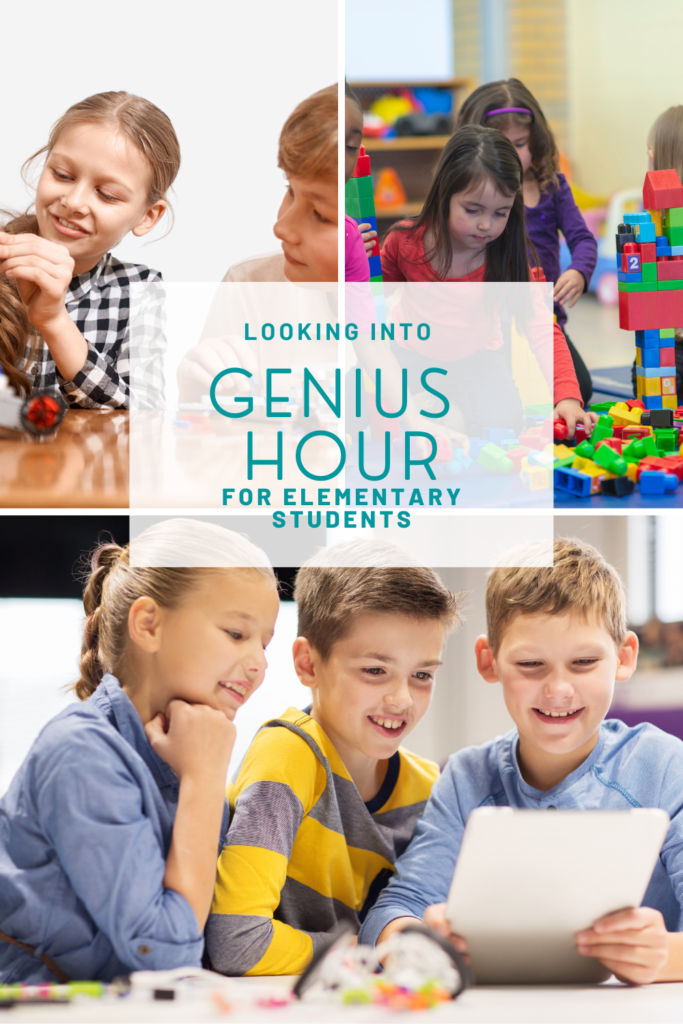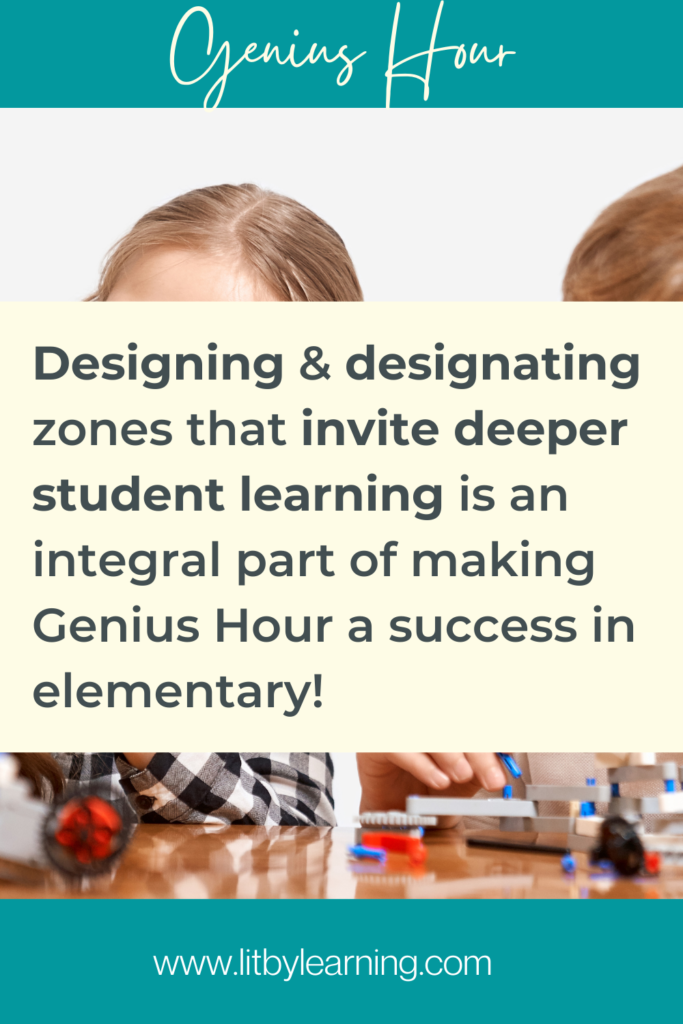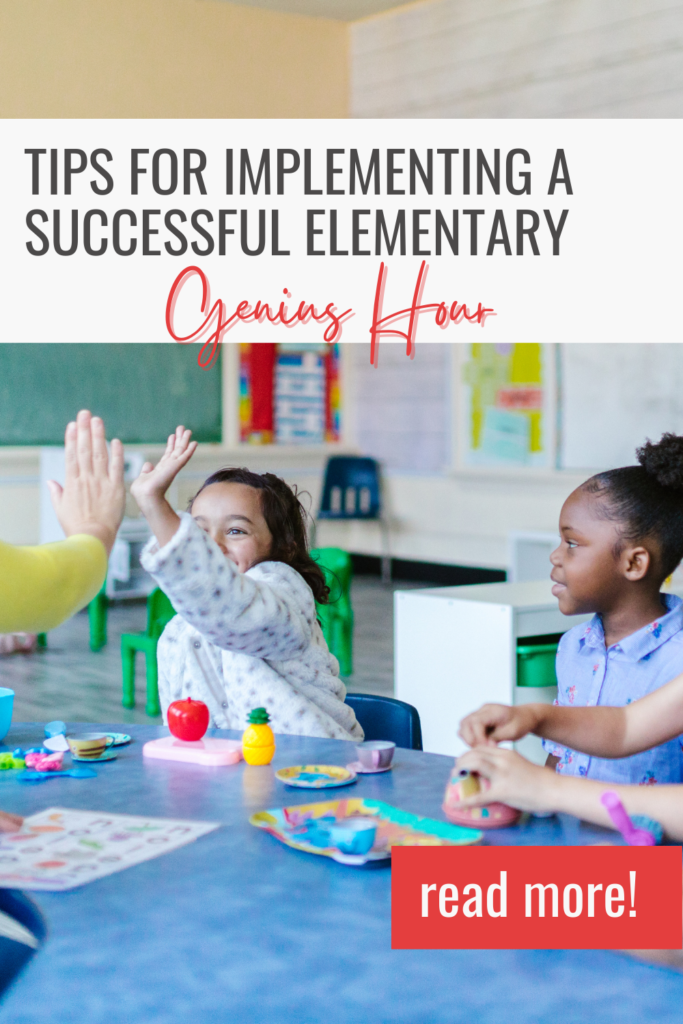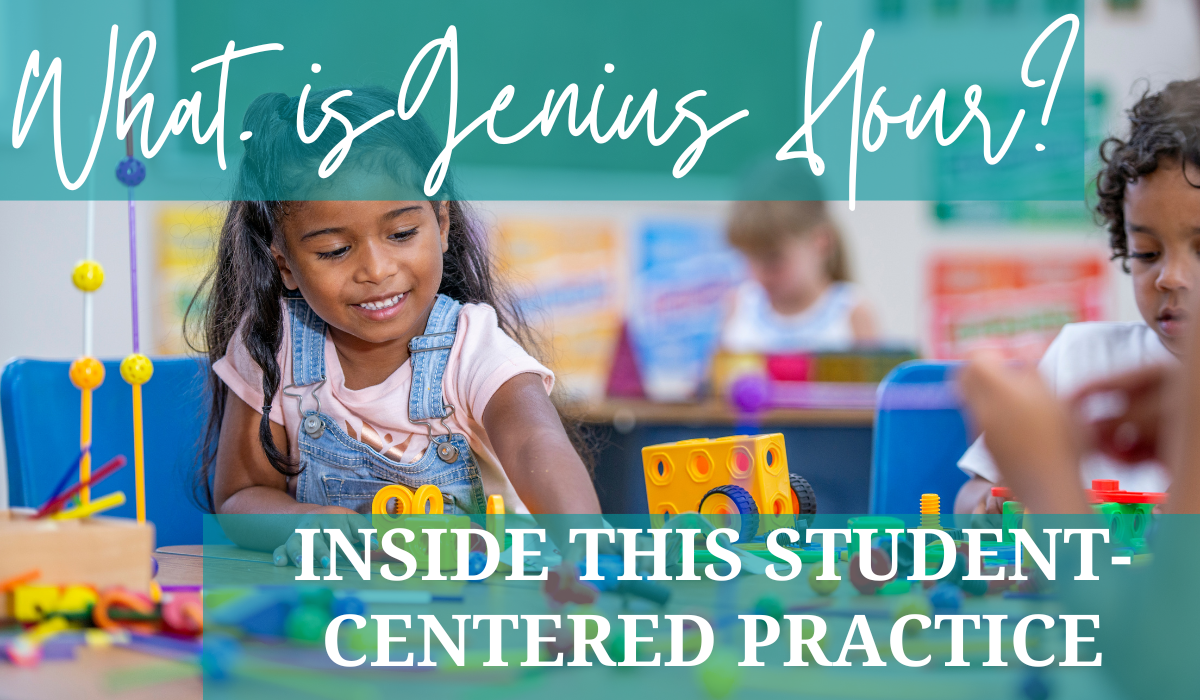Elementary teachers, are you looking for a creative and innovative way to engage with students? Discover the power of Genius Hour, a student-centered educational practice that allows them to explore their passions while learning.
Grab your guide!
If you’re here to learn more about the student-centered practice of Genius Hour, you’re my kind of dedicated elementary teacher! Grab your free guide to a learner-led classroom here!

What is Genius Hour?
Genius Hour is an educational strategy originally inspired by Google’s employee enrichment policy. It focuses on student-centered learning, encouraging students to explore topics of their own interest in a collaborative environment. With the help of their teacher, students create individual projects to work on during class time and develop skills such as self-directed learning, creativity, collaboration and problem solving.
Understand the basics of Genius Hour
The basic premise behind Genius Hour is that students should be given an opportunity to explore and pursue topics that interest them. This means dedicating a certain amount of class time each week for the students to work on their individual projects. Throughout the process, students are expected to research, brainstorm and create their own unique idea or project. The goal of Genius Hour is to foster student engagement in their learning process and help them develop skills that will be valuable for their future endeavors.
My personal connection to Genius Hour
I first learned the name “Genius Hour” through my work with the Academy Group one summer in Chicago. Part of our students’ weekly schedule was a student-centered genius hour. During this time, the 4th-5th grade students I was teaching could pick any number of activities or projects to explore. Some choose movie/video production, others worked with an array of art materials to create, and still others spent the time designing a social-emotional learning campaign to promote kindness in our program. While a bit chaotic in practice, the students were generally engaged and looked forward to this time.

Genius Hour is time for student-centered deep play
As I observed the students who were the most engaged, I couldn’t help but make deep connections between what I witnessed during Genius Hour and what I had observed during Open Play time as a Pre-K teacher years earlier. In both situations, the students were using a lot of collaborative creative phrases like:
- “Ok, yeah, but what if we also…?”
- “How about if…?”
- “Let try this: you _____ and I ____.”
Connecting the dots, I realized that, at best, Genius Hour is deep play: students were pursuing their interests without limits or restrictions in a creative, often cross-curricular, way. Students were laughing, building on others’ ideas, and problem-solving in ways we teachers often dream about.
Another short note: check out this definition of the state of flow for adults – to me, it’s deeply connected to the student-centered tenets of Genius Hour and free play!

The right Genius hour structure will vary dependeing on your students!
Of course, there are many different formats for Genius Hour and upper grades often ofter more planning and structure. One thing that’s important to me when designing our completely student-centered time is that everything be accessible for all students to do independently. Since not all of my first graders are reading or writing independently, I would view a written plan or something like it as a barrier for access and, to use a sophisticated pedagogical phrase, a fun-sucker. We are extremely purposeful with our instruction time at all other hours of the week. It is more than fine by me that my 1st graders get to make an in-the-moment, what sounds good right now decision for Genius Hour.
One thing that’s important to me when designing our completely student-centered time is that everything be accessible for all students to do independently.

Student-centered genius hour in my first-grade classroom
So let’s get practical: what does genius hour actually look and sound like in my first-grade classroom? How do we fit it in with our curriculum? How do I encourage total student autonomy while still maintaining classroom expectations?
When do we have genius hour?
We do Genius Hour each Friday afternoon during the final hour of school day. Once students return from specials classes at 1:00, we do either a short math lesson or assessment, then it’s time to gather for our pre-Genius hour meeting.
How do we get ready for genius hour?
For our whole-class, pre-Genius Hour meeting, students gather on the rug for a brief review of our learning this week. We recall all that we’ve explored in the past 5 days, often citing our working wall, texts, or student work to jog our memories. During this time, I plant seeds about what students might want to play with during their student-centered time. It sounds like this:
- “Yes! We were learning about sound waves and how sound comes from vibrations! I wonder if some of you aren’t going to chose to play more with the box guitars we made!”
- “You may notice that I left out some extra bonus writing paper in the back. I thought that perhaps some of you might want to make up another silly fairy tale during our choice time. I can’t want to see what you think of!”
- “In this box, I have some other materials that could make patterns like we’ve been talking about in math. I’m curious to see if any of you might make new designs – I will take pictures of what I see!”
This time builds excitement and highlights students’ choices for the next hour of student-centered fun.
What is available during this student-centered time?
OK, so what are students’ choices during Genius hour? I have some centers/areas of the room that are permanent fixtures in this student-centered learning block – and othes that change according to students’ interests and our curriculum.
Our always-open choices are:
- Duplos: I inherited two bins of Duplo blocks from the teacher in my class before and they are always a hit.
- Magna-Tiles: We got these from a Donors Choose project and they’re a classroom favorite, too!
- Cups: Literally, paper Dixie Cups that I’ve had for years. Students get SO creative with stacking these!
- Library: Students can go to the library and peruse any of our books! See more about my classroom library here. You might be surprised at the number of students who choose to spend their time paging through familiar books or investigating new ones.
- Arts and Crafts: Tape, construction paper, scrap paper, yarn, watercolor paints, markers, crayons, many types of scissors, fabric scraps, magazines, paper towel and toilet paper rolls, boxes – our self-serve art center is open during Genius Hour each week!
- iPads: Students. are welcome to use their iPads to work on one of our learning programs or to do research. Approximately 0 students choose this each week, but I find it’s a good back-pocket option for someone who’s not in the mood to do a collaborative project.
Our sometimes-open, more topical or seasonal choices are:
- Science-related materials and stations: We’ve had a shadow cave, an instrument exploration, make-your-own creature studies, and much more to correspond with our science curriculum!
- Rotating sensory experiences: Play Doh, clay, imaginary snow, water. These change on (honesty time!) what I have on hand and student interests. Right now, I have a group of students super interested in gardening, etc. so I have a few pots of dirt where they can put seeds found outside or saved from lunches. I’ve also set up a propagation station where they can check out the rooting process!
I strongly believe in the Regiio Emila belief that the classroom environment is the “third teacher”. Designing & designating zones that invite deeper student learning is an integral part of making Genius Hour a success in elementary!

Setting up for success: Genius Hour implementation tips
I wouldn’t consider myself a Genius Hour expert, but I have assembled a list of what I’ve found works through trial and error in my own classroom.
Let logical consequences rule
Cleaning up
The only way that we can keep doing genius hour is if the last genius hour was cleaned up and conducted successfully. ALL students are expected to help clean up from ALL parts of the classroom, even if it’s not where they worked that day. If a center is not properly cleaned up or requires too much teacher help, it’s closed for the next week’s genius hour or until students who want to play there have developed a plan for clean up.
Conflicts
Students will have conflicts! Remember: this time as about them and their indepenence and problem solving. When students come up with an issue, I ask THEM to brainstorm next steps: “how do you think you can work this out so that we can all enjoy this fun time?” If someone is repeatedly causing issues in one area of play or is using materials inappropriately, I’ll direct them to choose a new place to work. We always return to our co-created expectations to guide this time, just like any other time at school.

Say yes as often as possible
Do students want to bring in some materials from home to work with? Sounds like a plan. Do students want to access things that are usually only in the art or music room? I can do my best to make that happen. Do students need to store work to continue with next week? Let’s do it. Perhaps they want a picture to remember or share their work. I’ve got a camera. The more (safe) yes’s you’re able to provide during this time, the more creativity you’ll observe sparked in your students.
Do not force academics
Repeat with me: this is their, student-directed time. Students may take you up on the curriculum-related choice activities or they may choose Duplos week after week. It is OK. Play in itself is learning, so we don’t need over-push current concepts on students during Genius Hour.
Be consistent and don’t gate-keep
Genius hour shouldn’t be something students have to earn. It should be a guaranteed part of thier academic schedule and not taken away. They should be able to have an idea during reading on Tuesday and KNOW that they’ll get to try it out during Genius Hour that week. Students should be able to know that, even if they run out of time to work on their choice writing project, they’ll be able to really dive into during their choice time. Bonus: This helps students stay on task during other work times because they can COUNT ON their own time during Genius Hour.

Learn more about Genius Hour!
- Check out this video by TheEdTech Classroom!
- Read this article by WeAreTeachers.
- Curious about Genius Hour for older students? Check out this Edutopia article!
Read more from Lit By Learning!
Check out these other blog posts for more ideas about student-centered teaching practices in your elementary classroom!


